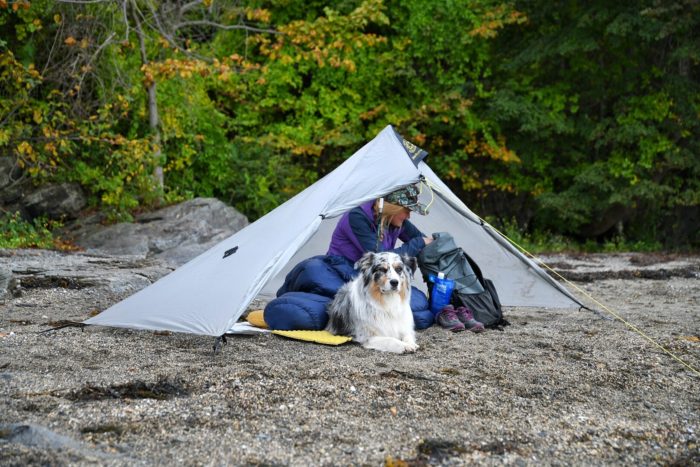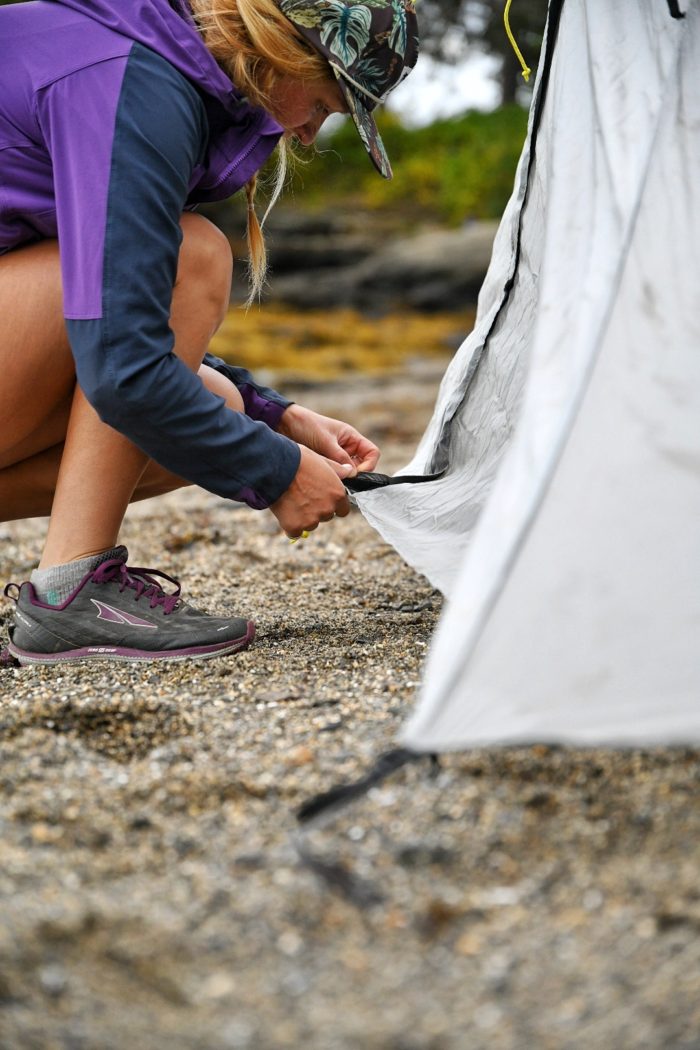Gear Review: Six Moon Designs Deschutes Tarp
A minimal shelter isn’t for everyone. Ultralight tarps shed weight, space, and money for hikers looking to go the distance. The Six Moon Designs Deschutes is a solo tarp that does just that: simplifies. There’s no floor, no pockets, no anything that’s not totally essential. It gets the job done at an affordable price while keeping you cozy and comfortable.
SMD Deschutes Specs
Weight: 13 ounces (not including stakes or groundsheet)
Materials: 20D silicone coated nylon
Packed Size: 12 inches by 4.5 inches
Style: Tarp
Sleeps: One person
Seasons: Three
MSRP: $175
Circumstances of Review
Over the past few months, I’ve slept under the Deschutes along the PCT in California, the Winds of Wyoming, New Hampshire’s White Mountains, and Maine’s coast. It’s seen the weather of dry deserts to humid forests and alpine basins. I used it only as a tarp (no NetTent) weighing in at 15 ounces with my groundsheet and stakes.
Notable Features
Coverage: 44 square feet of space and a setup height of 49 inches.
Material: 20D silicone coated nylon (3,000mm rating) is light but durable.
Single-Pole Pyramid: Hexagon shape is easy to set up and provides 360-degree weather protection from wind, rain and snow.
Long Zippered Entry: Full-length vestibule zipper makes for easy entry and one or both sides can be tucked away for better ventilation and space.
Adjustable: Height of pole can be changed to help manage weather and condensation.
Optional Bug Insert: When paired with the Serenity NetTent, you have a three-season double wall tent that weighs in at 24 ounces.
Top Vent: Ceiling vent to help circulate airflow and prevent condensation when things are buttoned up.
Pros
Easy to Pitch: Because of this tarp’s simple design, it’s quick to set up, using six stakes and one trekking pole (SMD has carbon poles available). Like any tarp, it can take a few times to get the feel for it, but this one is straightforward.
Roomy: Depending on how it’s pitched, the pole can extend higher for more internal height, or lower for more length and wind protection. The Deschutes has plenty of usable space and doesn’t feel tight at all, which I’ve found in other tarps. It comfortably fits one person, with gear (and a dog in my case) and would fit two in an emergency.

Details include a top vent and reflective guylines. Packs down to about the size of my NeoAir X-Lite.
Ultralight: It’s true that Dyneema is lighter than silnylon, but for a significant price increase. This tarp alone weighs in just under 13 ounces and my whole system with a Tyvec groundsheet and stakes weighs 15 ounces. A shelter that weighs under a pound that cost less than $200? Yes, please.
Weather Protection: Unlike a flat tarp, the Deschutes’ mid-style design has full 360-degree protection from the elements. I was really comfortable and dry during a number of stormy nights.
Cons
Condensation: Like all single-wall silnylon shelters, the Deschutes is susceptible to condensation. This means users need to be be more mindful about where and how you setup to avoid a wet morning- pitch under trees, sleep with the doors open to help circulate airflow, keep sleeping bags off the sidewalls in damper climates. Condensation can cause the tarp to sag once the nighttime temperature drops, so try tightening the tie-outs just before bed, and hook up guylines to the two additional attachment points at the rear.
Doesn’t Stand Alone: The Deschutes Tarp alone might not be suitable for everyone. Without the insert and depending on your climate, it might not pass as a three-season shelter (I’m looking at you, mountain-climate spring). Depending on the user’s tolerance for the elements, there may be trips that call for an additional bivy or the NetTent insert if you’re concerned about insects or cold weather. The downside of the bug net insert is that it really cuts down on space since the shape is hexagonal.
Manufactured in China: Presumably this is why their prices are competitive. Tarps are seam-sealed in the US (if you’ve purchased that add-on service), but are otherwise made overseas. The Deschutes seems well-constructed nevertheless, but I was disappointed to learn a cottage brand like SMD was no longer producing in-house.
Careful, Tall People: There’s enough headroom here, but much of it depends on the height of the sleeping pad you’re using. I think anyone over six feet might need to nail down their pitching technique to avoid brushing up against the sides.
Overall Value
For thru-hikers and backpackers looking for a simple ultralight shelter, the Deschutes Solo Tarp is a reliable and affordable choice. It’s not flashy, but it’s a shelter for anyone who likes to hike long days and optimize space in their pack. Depending on tolerance for the elements (or with the addition of the NetTent), the Deschutes could be a great three-season tarp for a long-distance hike on the PCT or CDT. At $175 and 13 ounces, this is a solid choice to go ultralight on a budget.
Comparable Items
Mountain Laurel Designs Cricket Pyramid Tarp $185
Zpacks Hexamid Pocket Tarp $199
Six Moon Designs Gatewood Cape $135
Shop the SMD Deschutes Tarp Here
Disclosure: This product was donated for purpose of review.
Contributing photos courtesy of Emily “Momo” Sawchuck
This website contains affiliate links, which means The Trek may receive a percentage of any product or service you purchase using the links in the articles or advertisements. The buyer pays the same price as they would otherwise, and your purchase helps to support The Trek's ongoing goal to serve you quality backpacking advice and information. Thanks for your support!
To learn more, please visit the About This Site page.






Comments 1
That was a smart review. I love my Deschutes Tarp and I am 6’5″, 250lbs. I do have to get my pitches right and keep it tought. The pullouts at head and foot help a lot. Also I find that attaching 2 patches to the back helps with air flow immensely. The back doesn’t sag much but left and right of middle seam, low to mid area will pull out 6″ which seems insignificant until you notice the luxurious increased air flow in the back half of the tent. You can include loops inside on those patches to further pull out the inner tent. The Serenity tent is, as you said, unnecessarily small. Mine was lost in the mail so I discovered I could get a 3F UL Lanshan inner tent that is 90″ long, 30″ wide with a middle rear extension of 8″ and 45″ tall. Fits me with a few small things and fits the tent. I think it is well made and I like it. There is also a winter version with fabric and a mesh vent on top. Both about $55 on Ali Express with 4-6 weeks shipping.
I wish there was a winter version Deschutes Tarp: 5% bigger, lower in front, heavier denier, heavier tie outs, maybe a 2nd vent on top with both zippered. Probably would be an oddity but I would try it. The low slope in back might not handle much snow. Then again, the back tail is for shedding wind, not for usable space. But it would likely deform and stress the tent if it were overloaded.
That’s all my thoughts!